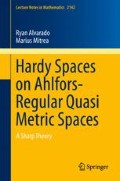Abstract
The main goal of this chapter is to introduce Hardy spaces in the context of d-Ahlfors-regular quasi-metric spaces by defining H p(X) as a collection of distributions whose maximal belongs to L p(X). This is in the spirit of the pioneering work of C.
Access this chapter
Tax calculation will be finalised at checkout
Purchases are for personal use only
Notes
- 1.
which essentially make it an approximation to the identity
- 2.
- 3.
In this work, the pair \((\mathcal{X},\tau )\) shall be referred to as a topological vector space provided \(\mathcal{X}\) is a vector space and τ is a topology on \(\mathcal{X}\) such that the vector space operations of addition and scalar multiplication are continuous with respect to τ. Under these assumptions, the topological space \((\mathcal{X},\tau )\) may not be Hausdorff. If, in addition to the above considerations, one assumes that the set \(\{x\} \subseteq (\mathcal{X},\tau )\) is closed for each \(x \in \mathcal{X}\) then \((\mathcal{X},\tau )\) is necessarily Hausdorff. In light of this, part of the literature includes the latter condition in the definition of a topological vector space (see, e.g., [Ru91, p. 7]).
- 4.
Given a vector space \(\mathcal{X}\) over \(\mathbb{C}\), call a function \(\|\cdot \|: \mathcal{X} \rightarrow [0,\infty )\) a quasi-norm provided there exists a constant C ∈ (0, ∞) such that for each \(x,y \in \mathcal{X}\) the following three conditions hold (i) \(\|x\| = 0\, \Leftrightarrow \, x = 0\), (ii) \(\|\lambda x\| = \vert \lambda \vert \cdot \| x\|\), \(\forall \,\lambda \in \mathbb{C}\), and (iii) \(\|x + y\| \leq C(\|x\| +\| y\|)\).
- 5.
This variety of Hardy spaces was introduced in [MiMiMiMo13] where the authors considered a slightly less general geometric measure theoretic ambient than the one in this work.
- 6.
This class of Hardy spaces was introduced in [MaSe79ii] in the setting of normal spaces (1-AR spaces) although the notation is due to the authors in [MiMiMiMo13].
- 7.
Given a vector space \(\mathcal{X}\) over \(\mathbb{C}\), call a function \(\|\cdot \|: \mathcal{X} \rightarrow [0,\infty )\) a quasi-semi-norm provided there exists a constant C ∈ (0, ∞) with the property that for each \(x,y \in \mathcal{X}\) the following three conditions hold (i) x = 0 implies that \(\|x\| = 0\), (ii) \(\|\lambda x\| = \vert \lambda \vert \cdot \| x\|\), \(\forall \,\lambda \in \mathbb{C}\), and also (iii) \(\|x + y\| \leq C(\|x\| +\| y\|)\).
- 8.
Given \(z \in \mathbb{C}\) we denote by \(\mathrm{Re}z \in \mathbb{R}\) and \(\mathrm{Im}z \in \mathbb{R}\), respectively, the real and imaginary parts of z.
- 9.
Call a pair \((\mathcal{X},\|\cdot \|)\) (or simply \(\mathcal{X}\)) a quasi-Banach space provided \(\mathcal{X}\) is a vector space (over \(\mathbb{C}\)) and \(\|\cdot \|\) is a quasi-norm on \(\mathcal{X}\) with the property that \(\mathcal{X}\) is complete in the quasi-norm \(\|\cdot \|\), i.e., every sequence of points in \(\mathcal{X}\) which is Cauchy with respect to \(\|\cdot \|\) converges to a point in \(\mathcal{X}\).
References
R.R. Coifman, A real variable characterization of H p. Studia Math. 51, 269–274 (1974)
R.R. Coifman, G. Weiss, Extensions of Hardy spaces and their use in analysis. Bull. Am. Math. Soc. 83(4), 569–645 (1977)
C. Fefferman, E. M. Stein, H p spaces of several variables. Acta Math. 129(3–4), 137–193 (1972)
L. Grafakos, L. Liu, D. Yang, Radial maximal function characterizations for Hardy spaces on RD-spaces. Bull. Soc. Math. France 137(2), 225–251 (2009)
L. Grafakos, L. Liu, D. Yang, Maximal function characterizations of Hardy spaces on RD-spaces and their applications. Sci. China Ser. A 51(12), 2253–2284 (2008)
Y. Han, D. Müller, D. Yang, Littlewood-Paley characterizations for Hardy spaces on spaces of homogeneous type. Math. Nachr. 279(13–14), 1505–1537 (2006)
Y.-S. Han, E.T. Sawyer, Littlewood-paley theory on spaces of homogeneous type and the classical function spaces. Mem. Am. Math. Soc. 110(530), 1–126 (1994)
L. Hörmander, The Analysis of Linear Partial Differential Operators, vol. I (reprint of the 2-nd edition 1990) (Springer, New York, 2003)
R.H. Latter, The Atomic Decomposition of Hardy Spaces, pp. 275–279 in Harmonic Analysis in Euclidean Spaces (Proc. Sympos. Pure Math., Williams Coll., Williamstown, MA), Part 1, Proc. Sympos. Pure Math., Vol. XXXV (Amer. Math. Soc., Providence, RI, 1979)
W. Li, A maximal function characterization of Hardy spaces on spaces of homogeneous type. Approx. Theory Appl. (N.S.) 14(2), 12–27 (1998)
R.A. Macías, C. Segovia, A Decomposition into atoms of distributions on spaces of homogeneous type. Adv. Math. 33(3), 271–309 (1979)
D. Mitrea, I. Mitrea, M. Mitrea, S. Monniaux, Groupoid Metrization Theory with Applications to Analysis on Quasi-Metric Spaces and Functional Analysis. Applied and Numerical Harmonic Analysis (Birkhäuser/Springer, New York, 2013)
W. Rudin, Functional Analysis, 2nd edn. International Series in Pure and Applied Mathematics (McGraw-Hill, New York, 1991)
E.M. Stein, Harmonic Analysis: Real-Variable Methods, Orthogonality, and Oscillatory Integrals, Princeton Mathematical Series, No. 43. Monographs in Harmonic Analysis (Princeton University Press, Princeton, NJ, 1993)
A. Uchiyama, A maximal function cha,racterization of H p on the space of homogeneous type. Trans. Am. Math. Soc. 262(2), 579–592 (1980)
D. Yang, Y. Zhou, Radial maximal function characterizations of Hardy spaces on RD-spaces and their applications. Math. Ann. 346, 307–333 (2010)
Author information
Authors and Affiliations
Rights and permissions
Copyright information
© 2015 Springer International Publishing Switzerland
About this chapter
Cite this chapter
Alvarado, R., Mitrea, M. (2015). Maximal Theory of Hardy Spaces. In: Hardy Spaces on Ahlfors-Regular Quasi Metric Spaces. Lecture Notes in Mathematics, vol 2142. Springer, Cham. https://doi.org/10.1007/978-3-319-18132-5_4
Download citation
DOI: https://doi.org/10.1007/978-3-319-18132-5_4
Publisher Name: Springer, Cham
Print ISBN: 978-3-319-18131-8
Online ISBN: 978-3-319-18132-5
eBook Packages: Mathematics and StatisticsMathematics and Statistics (R0)

